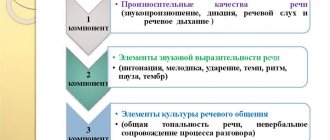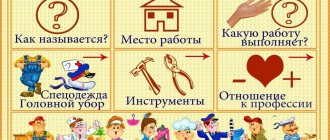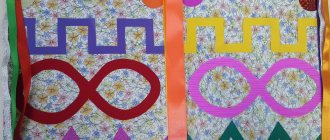Preparing for the drawing lesson “Dishes”
Drawing dishes is carried out simultaneously with the study of this topic in cognitive and speech classes. Children convey the characteristic features of everyday objects in drawings:
- shape (bowl, plate - round, cutlery - oblong),
- size (saucer smaller than plate, for example),
- color and pattern,
- purpose (glass - for compote, bowl - for vegetables).
Children can draw and paint dishes
Paints and base for painting
- Gouache is the paint of choice for painting with 5 year olds. Lines and strokes are clearly laid out, the color is rich. You can use watercolors (after all, these paints are cheaper than gouache).
- Brushes: thick and thin made of natural bristles.
- Colored pencils (not wax).
- Landscape sheet or half: white,
- tinted with watercolor paint (by the teacher).
Advice. Save markers for drawing details in the older group, and leave wax crayons for unconventional techniques with watercolors. The purpose of classes in the middle group is to teach object drawing with pencils and paints.
Gouache works best for children 4–5 years old to color.
Drawing technique
- Practice drawing shapes: with a finger/dry brush in the air or on a desk.
- Drawing an outline on paper (brush or pencil).
- Coloring: pencil shading,
- strokes of paint.
- border,
Painting utensils may include coloring and decorating
Video: drawing lesson for children “Cup and teapot”
The drawing lesson is intended by the author for children from three years old. In fact, primary and secondary preschoolers will be able to reproduce only part of what is shown in the video: the shape of a cup (semicircle) and a teapot (circle), painted over and completed with pens, a simple pattern.
Decorating a drawing or paper blank on the topic “Dishes” can be done using an unconventional technique:
- fingers,
- cotton swabs,
- stamps,
- imprinting dry leaves, cut fruits.
Photo gallery: drawings of dishes using non-traditional techniques
It’s fun to draw with a cotton swab; you get even peas
Children use their fingers to draw in the style of dot painting.
Leaf prints on the plate form a beautiful pattern
You can make stamps for decorating plates yourself: cut them out on pieces of vegetables
How to decorate a drawing
Aesthetic education of children is carried out in the interrelation of play, productive creativity, and the influence of the developing environment. Fine arts classes have one of the main objectives - to instill a sense of beauty in the younger generation. Stimulate and encourage the child’s desire to further decorate the drawing with various materials:
- plasticine circles (mosaic) or strokes (plasticineography),
- pieces of fabric, colored or wrapping paper (applique),
- glitter.
Plasticine elements can be used to mark the contours of dishes and make a three-dimensional pattern.
Individual tasks
An individual-personal approach to the work of a teacher is to adapt the conditions for each child in such a way that the tasks are feasible and at the same time develop. There are children in the group whose skills are still less developed than those of their peers - for them it is worth simplifying the task. But gifted children will quickly cope with the general task and get bored - they need more complicated tasks.
An example of multi-level tasks in the “Cup for Grandma” lesson:
- simplified - trace the stencil of the cup, outline the outline with gouache, paint over it, decorate with pieces of plasticine;
- general - draw a cup, color it, add a polka dot pattern;
- with a complication - draw a cup, decorate it in the style of folk crafts (Gzhel, Khokhloma).
In addition, you can individualize the task for everyone: through the choice of a tinted base, blank, stencil or paints. Children love being trusted to figure out some of the work themselves.
The ability to independently choose a subject to draw motivates children
Place of classes in the card index for visual activities
The topic “Utensils” is general and significant for different classes in the middle group. Children will learn what types of utensils exist and what materials they are made from. The culture of behavior at the table and eating food is covered in role-playing games.
During art classes, children depict familiar types of dishes. Individual works can be compiled into a collective composition. The theme of dishes and utensils is interpreted in drawing classes in a variety of formulations:
- “Cup for mommy”, “Tea pair” / “Cup and saucer for beloved grandmother” (for a gift on March 8),
- “Bowls of Three Bears” (individual composition to maintain proportions),
- “Treat for friends”, “Plate with vegetables/fruits” (drawing a base for plasticine fruits),
- “Gzhel patterns” (decorative drawing),
- “Dishes for Fedora” (collective composition based on the poem, the teacher draws Fedora based on it),
- “Tea service” (collective composition).
The drawings of all pupils can be arranged, for example, into the composition “Tea Party”
Game 1. We treat guests. We play with words.
We learn to form new words from known ones (names of tableware).
Meet Tanya and Vanya. Their friends came to visit Tanya and Vanya. The guys invited the guests to the table. Look at the pictures and name what dishes the children put on the table. For oil - a butter dish, and for salt -...? (Salt shaker) For soup - a tureen, for sweets - ...? (candy bowl), for sugar - ...? (sugar bowl), for bread -... (bread box). For milk - a milk jug, for salad - ...? (salad bowl), and for coffee -...? (coffee pot). What kind of dishes does your mother put on the table when guests come to you? (carefully look at the dishes at home, name them, look at the details and name them - handle, spout, lid, bottom)
Listen to a poem about dishes. (The poem “Dispute” will help the child learn to correctly name different dishes. While reading, show the child the dishes shown in the picture)
I came up with this poem for classes with children, and they really liked it. It also helped me quickly learn the names of different utensils. I hope that you and your children will get great pleasure from the poems in pictures.
You will find this poem in pictures, as well as other tasks in pictures, in the article “Pictures of dishes for children”
You will find a presentation on this poem with pictures in good resolution for more convenient viewing with children in our VKontakte group “Child development from birth to school” (section of the “Documents” group on the right under the group video)
Dispute.
Once the dishes started arguing, Who is the most important in the world? “I’m more important,” the teapot told everyone. I warm tea for people.
“And without us they won’t be able to eat the soup. A spoon is also a friend to people.” Then the pots answered them: “You can’t cook dinner without us!”
The frying pan hissed: “That’s what I wanted to say. I fry cutlets for people, and potatoes, and omelettes.”
Stop this argument, useless conversation. We need all the dishes, each one is important to us.
We put butter in a butter dish , pour salt into a salt shaker . We put bread in the bread bin , and take soup from the tureen .
We also have a kettle with tea. We don’t miss drinking tea And pour sweet sugar from a bright sugar bowl
There is a milk jug with milk and a coffee pot with a rim. There are candies in the candy bowl for both Masha and Sveta.
There are a lot of different dishes and we need them everywhere! And we cook, and we eat, and we store food in it. (Author - Valasina A.V.)
Why do people need different dishes? What would happen if there were no dishes?
Read the poem again and ask your child to finish the words after you - the names of the utensils. For example, “We put butter in the oil...(liner), pour salt in the salt...(lonker)."
Game 2. What's missing?
We learn to accurately name the parts of the dishes. We learn to use the genitive case in speech.
Let's remember the fairy tale by K.I. Chukovsky “Fedorino's grief”.
Tell me why the dishes ran away from Fedora? Look at Fedora's broken dishes. What is missing from a cup, pan, teapot?
“A cup without...(handle).”
“A saucepan without...(lid).”
“A teapot without ... (spout).”
-Is it convenient to use a cup without a handle? Why? Why do cups have a handle? What other utensils have a handle? (At the frying pan, at the saucepan, at the kettle, at the milk jug, at the coffee pot). Why do these items need handles?
-Why do you need a lid on the pan? What other items have you seen with lids?
-Can I use a kettle without a spout? Why? What other objects have a spout? (At the watering can, at the coffee pot, at the milkman). What is the spout for?
Why did the dishes return to Fedora? What would happen if the dishes didn't come home? How did Fedora begin to take care of her dishes? (Washed it, cleaned it, doused it with boiling water, rinsed it, didn’t beat it...)
Game 3. Guess the riddle.
We learn to reason, identify and accurately name the characteristics of objects.
You will need three toys or three pictures for your child to choose a answer: a frying pan, a saucepan, a kettle (but in no case should the kettle be the first in the row).
Ask your child to guess the riddle:
“I puff, puff, puff, I don’t want to get warm anymore. The lid rang loudly: “Drink tea, the water has boiled!” What is this? Find the answer.
Do not rush to give the correct answer, give the child the opportunity to reason and think. Be sure to provoke him to prove his opinion by making a deliberate mistake. You can say: “Why did you think it was a teapot? Maybe it’s a saucepan, it’s also puffing?” Let the child listen to the riddle again and try to prove his opinion. Then ask again: “Or maybe it’s a frying pan, does it get hot too?” Re-read the riddle again and find in it the signs of the object, name them together with the child: it has a lid, it puffs and warms itself on the stove, it boils water for tea. Why isn’t this a frying pan?
These deliberate mistakes, which encourage the baby to reason, can be made by Mishka - Toropyzhka or Dunno, whom you invite to solve riddles with the baby.
Tips for parents:
- Remember that it is at the age of 3-4 that a child’s word creation begins. Don’t scold your child for making up words like “for salt – Solnitsa, for butter – Maslenitsa (Shrovetide).” The child’s word creativity must be encouraged. It indicates the child’s experimentation with words, his active mental activity. Without playing with words, it is impossible to fully master the grammar of your native language in all its completeness and richness! If you make a mistake, do not repeat it after your child, just immediately say the correct version of the word: “People agreed to call the utensils for butter a butter dish, and the utensils for salt a salt shaker.”
— Games for children 3 years old should not be long. They are always funny, entertaining, and built in dialogue with the child. Having learned the names of utensils in the game, the purpose of their parts, be sure to repeat this material (look at the dishes at home, at your grandmother’s, in the store, draw your child’s attention to the interesting shapes of handles, lids, spouts, try to sketch them; if your child is already 4- 5 years, you can look at the dishes in the museum - how they differ from our dishes at home, what they are called, what they were previously used for). When examining objects, be sure to give them to the baby’s hands so that he can run his finger along the contour, determining their shape; I tried holding it with the handle and without the handle - whichever was more convenient.
continued games with children 3 years old and older in the following article: “Dishes: tasks in pictures for children”
all the pictures of the article for more convenient viewing with children in our VKontakte group (see the group section “Documents” - presentation “Dishes”, the presentation is available for editing). Or watch the presentation below. To view full screen, you need to click the arrow icon in the lower right corner of the screen.
Decorative and souvenir types
Plates are used not only for their intended purpose, but also as a decorative element. Painting, photo printing, beads, and other techniques are used for decoration. Beautiful decorative plates decorate the walls; they are placed in cabinets on shelves in special stands.
Artistic and decorative plates are made from clay, ceramics, porcelain, colored glass, wood and paper pulp (papier-mâché).
You can’t do without plates, but you don’t have to buy all types; use interchangeable ones so as not to clutter your cabinets with unnecessary utensils.
Three pillars of the everyday table
The minimum set should include three types of table plates - for first and second courses, as well as dessert. They can replace additional dishes if there are none in the house.
Dining rooms
Depending on the depth and size, dinner plates come in two types:
- Deep - with a capacity of up to 500 ml, with a diameter of 24 cm. Used for serving first courses, as well as for some hot dishes containing sauces and gravy.
- Small - the most common and popular plate with a diameter of 24 cm, it is used for serving main courses and hot appetizers: fish, meat, poultry.
These two types can be classified as mandatory, but it will not be difficult to replace them with other varieties. Moreover, the classic deep dinner plate is less popular today; it has been replaced by deeper plates with a smaller diameter and less pronounced sides.
Soup
Which plate should I put for soup or borscht? Of course - soup, but there are several types, differing in volume, depth, shape.
Deep portioned soup bowls hold 0.5 liters. The standard diameter is from 23 to 27 cm, the sides are wide, slightly beveled to protect the table from drops. In such dishes, soups cool faster and look beautiful - the ingredients are clearly visible over a large area.
Semi-portioned soup bowls have a volume of 0.25 liters and a diameter of 20-25 cm, suitable for children and those who prefer not to overeat.
If you don’t like the large diameter, you can choose a modern option - a deeper plate with a smaller volume, high and strongly sloping walls without pronounced sides. In this case, the soup will remain hot longer.
As an alternative for soups, people choose portioned tureens, bouillon bowls, bowls and even some salad bowls.
Dessert
Dessert serving plates have a diameter of 19 to 21 cm. They come in two types:
- Small – flat ones are intended for portion serving of pastries, cakes, muffins, mousses and other desserts.
- Deep - with a recess of 2-3 cm, used for serving desserts with sauces, sweet cereals, berries and fruits.
Dessert plates can be included in a set of tableware, and are also often included with tea and coffee sets. It is not difficult to find them separately - in sets of 6 pieces and individually.
Not only round – which shape is more convenient?
The word plate is associated with a round shape, but traditions can and should be broken. In addition to round ones, it is easy to find original square, almost oval, rectangular, triangular and shaped plates on sale.
The square shape is gaining popularity and no longer seems outlandish. Square dishes are chosen by people who do not like to be like everyone else and prefer to stand out in everything.
Square plates are more compact and look beautiful on the table. In the case of serving, it is easier to arrange them closer to each other and with the right approach there will be no visual clutter.
What kind of plate can be put in the microwave?
It is convenient to heat food in plates, but this can only be done if the material is microwave compatible. The best way to find out about compatibility is to review the information provided by the manufacturer.
What does the marking :
- Microwave safe - suitable for heating and cooking / But if this phrase is crossed out, then the manufacturer reports that the plate is incompatible with microwave ovens.
- Not recommended microwave - not recommended.
- Plastic marked PP is not suitable for hot food and is intended exclusively for storage at room temperature and in the refrigerator.
The following dishes should not be placed in the microwave oven:
- made of metals;
- with decoration using dyes containing metals (gilding, silvering);
- crystal;
- some types of porcelain and ceramics (intended exclusively for serving).
Suitable for microwave:
- heat-resistant and tempered glass;
- glass porcelain and glass ceramics;
- heat-resistant porcelain and ceramics for ovens;
- Microwave compatible plastic;
- silicone
Popular earthenware plates can be heated in the microwave, but for long-term cooking it is better not to use them, since the porous mass is prone to cracking.








